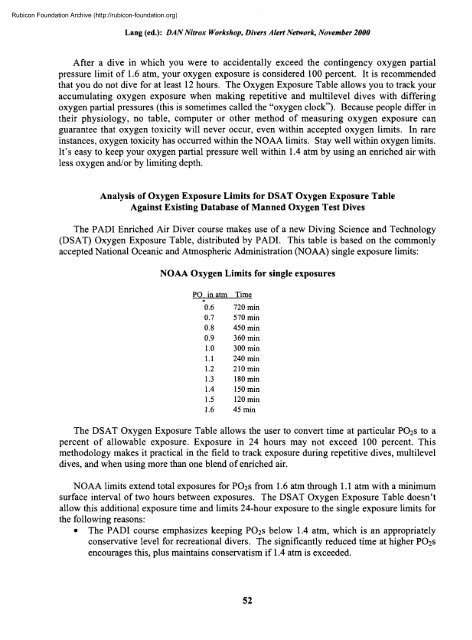Nitrox workshop dings - Divers Alert Network
Nitrox workshop dings - Divers Alert Network
Nitrox workshop dings - Divers Alert Network
You also want an ePaper? Increase the reach of your titles
YUMPU automatically turns print PDFs into web optimized ePapers that Google loves.
Rubicon Foundation Archive (http://rubicon-foundation.org)Lang (ed.): DAN <strong>Nitrox</strong> Workshop, <strong>Divers</strong> <strong>Alert</strong> <strong>Network</strong>, November 2000After a dive in which you were to accidentally exceed the contingency oxygen partialpressure limit of 1.6 atm, your oxygen exposure is considered 100 percent. It is recommendedthat you do not dive for at least 12 hours. The Oxygen Exposure Table allows you to track youraccumulating oxygen exposure when making repetitive and multilevel dives with differingoxygen partial pressures (this is sometimes called the "oxygen clock"). Because people differ intheir physiology, no table, computer or other method of measuring oxygen exposure canguarantee that oxygen toxicity will never occur, even within accepted oxygen limits. In rareinstances, oxygen toxicity has occurred within the NOAA limits. Stay well within oxygen limits.It's easy to keep your oxygen partial pressure well within 1.4 atm by using an enriched air withless oxygen and/or by limiting depth.Analysis of Oxygen Exposure Limits for DSAT Oxygen Exposure TableAgainst Existing Database of Manned Oxygen Test DivesThe PADI Enriched Air Diver course makes use of a new Diving Science and Technology(DSAT) Oxygen Exposure Table, distributed by PADI. This table is based on the commonlyaccepted National Oceanic and Atmospheric Administration (NOAA) single exposure limits:NOAA Oxygen Limits for single exposuresPO 2 in atm0.60.70.80.91.01.11.21.31.41.51.6Time720 min570 min450 min360 min300 min240 min210 min180 min150 min120 min45 minThe DSAT Oxygen Exposure Table allows the user to convert time at particular PO2S to apercent of allowable exposure. Exposure in 24 hours may not exceed 100 percent. Thismethodology makes it practical in the field to track exposure during repetitive dives, multileveldives, and when using more than one blend of enriched air.NOAA limits extend total exposures for PO2S from 1.6 atm through 1.1 atm with a minimumsurface interval of two hours between exposures. The DSAT Oxygen Exposure Table doesn'tallow this additional exposure time and limits 24-hour exposure to the single exposure limits forthe following reasons:• The PADI course emphasizes keeping PO2S below 1.4 atm, which is an appropriatelyconservative level for recreational divers. The significantly reduced time at higher PO2Sencourages this, plus maintains conservatism if 1.4 atm is exceeded.52
















